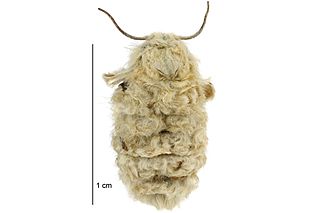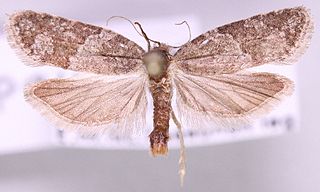
Graphium sarpedon, the common bluebottle or blue triangle in Australia, is a species of swallowtail butterfly that is found in East, South and Southeast Asia, as well as eastern Australia. There are approximately sixteen subspecies with differing geographical distributions.

Curetis thetis, the Indian sunbeam, is a species of lycaenid or red butterfly found in Indomalayan realm.

Daphnis nerii, the oleander hawk-moth or army green moth, is a moth of the family Sphingidae. It was described by Carl Linnaeus in his 1758 10th edition of Systema Naturae.

Acronicta rumicis, the knot grass moth, is a species of moth which is part of the genus Acronicta and family Noctuidae. It was first described by Carl Linnaeus in his 1758 10th edition of Systema Naturae. It is found in the Palearctic region. A. rumicis lives and feeds on plants located in wide-open areas. At its larval stage, as a caterpillar, it causes such a large impact as a crop pest that it has received much attention and research. A. rumicis feeds on maize, strawberries and other herbaceous plants.

Lophocampa ingens is a moth of the family Erebidae. It was described by Henry Edwards in 1881. It is found in the southern Rocky Mountains and in Mexico.

Sabatinca doroxena is a species of moth belonging to the family Micropterigidae. It is endemic to the North Island of New Zealand. This small moth has a colourful forewing pattern with stripes and dots evident. It has been hypothesised that the forewing pattern is intended to resemble a jumping spider in order to allow the adult moth to escape predation. Adults of this species are on the wing from the beginning of September until mid January. It prefers damp but sunny habitat in deep forest, at the forest edge or in open shrubland. Larvae feed on foliose liverwort species including on Heteroscyphus normalis. Adults of this species have been located at the blossoms of flowering Cordyline and Ranunculus species.

Metacrias erichrysa is a species of moth of the family Erebidae. It is endemic to New Zealand. This species can be found in the lower half of the North Island and western alpine areas of the South Island. The adult female of the species is flightless and buff coloured whereas the male is brightly coloured and a rapid flier during daylight hours. The male of the species is on the wing from mid-November to early January. The species inhabits open herb and tussock fields in mountainous terrain at altitudes of between 900 and 1200 m. Larvae feed on Brachyglottis bellidioides,Festuca novae-zealandiae and indigenous species from the genera Acaena, Muehlenbeckia, Wahlenbergia and Raoulia.

Heterocrossa eriphylla, also known as the lichen snoutlet moth, is a species of moth in the family Carposinidae. It is endemic to New Zealand and is found in the North Island and the northern parts of the South Island. This species is regarded as relatively uncommon and inhabits native forest. The larvae feed on the healing wounds of New Zealand beech trees Fuscospora fusca and Fuscospora truncata. It pupates at its feeding site and emerges from December onward. The adult moth is nocturnal and is attracted to light. During the day the moth rests on lichen covered tree trunks where their lichen mimicking colouration assists with their camouflage.
Trichoptilus pygmaeus is a moth of the family Pterophoridae. It is found in North America, including California, Florida and British Columbia.

Polyphagozerra coffeae, the red coffee borer or coffee carpenter, is a moth of the family Cossidae. It was described by John Nietner in 1861 and is found in Asia. Records from the Moluccas and New Guinea refer to Polyphagozerra reticulata, which was previously considered to be a synonym of P. coffeae. It is a widespread pest that attacks many plants.

Stephensia brunnichella is a moth of the family Elachistidae found in Europe and east into the Palearctic.

Polydesma umbricola, the monkeypod moth or large tabby, is a species of moth in the family Erebidae. The species is found in southern Europe, Africa, Asia Minor to southern Asia, of India, Sri Lanka, Maldives, the Andaman Islands, including many Indian Ocean islands, like Coëtivy Island, Aldabra, Assumption Island, Madagascar and on Hawaii.

Cnephasia pasiuana, the meadow shade, is a moth of the family Tortricidae. It was described by Jacob Hübner in 1799. It is found in almost all of Europe. The habitat consists of rough pastures, fens and marshy areas.

Ichneutica nullifera is a moth of the family Noctuidae. This species is endemic to New Zealand and can be found in the Tongariro National Park, along the Wellington coast and throughout the South Island. The adults are large and the forewing of adults can vary in colour from pale fawn to dark grey. The larvae are coloured a bright yellow-brown with a paler underside. The larval host species are in the genus Aciphylla and as a result the adult moths are often found in habitat dominated by species in this genus. Adults are on the wing from November to early April and are sometimes attracted to light.

Hierodoris atychioides is a moth of the family Oecophoridae. It was described by Arthur Gardiner Butler in 1877. The female holotype specimen held at the Natural History Museum, London. This species is endemic to New Zealand, and can be found in the North, South and Stewart Islands. The larvae form webs of silk attached to frass and leaves on their hosts in which they shelter, often in the company of other larvae in their species. Their feeding habits have not been observed in detail but Hoare hypothesises the larvae may feed on dead or dying leaves. The larvae feed on a wide range of trees and shrubs, including Dacrydium cupressinum, Prumnopitys taxifolia, Dacrycarpus dacrydioides, Libocedrus bidwillii, Cupressus macrocarpa, Leptospermum scoparium, Kunzea ericoides, Ozothamnus leptophyllus, Abies, Picea, Pinus and Thuja species. Although they are regarded as a pest of exotic forests in New Zealand, the economic damage the larvae cause is minimal and they tend to be controlled only by their natural enemies. Larval enemies include the parasitic flies Trigonospila brevifacies and Pales funesta as well as parasitic wasps including Xanthopimpla rhopaloceros. The adult moths are day flying and are most common during the months of December and January. This species is variable in appearance as larvae, pupa and as adults, and it has been hypothesised that it is in the process of speciation.
Gogana abnormalis is a moth in the family Drepanidae first described by Warren in 1897. It is found on Borneo, Sumatra and Peninsular Malaysia.
Acrojana sciron is a moth in the family Eupterotidae. It was described by Druce in 1887. It is found in Cameroon, the Democratic Republic of Congo (Katanga), Equatorial Guinea and Sierra Leone.
Dichomeris delotella is a moth in the family Gelechiidae. It was described by August Busck in 1909. It is found in Mexico (Sonora) and the southern United States, where it has been recorded from Arizona and California.
Microlechia chretieni is a moth in the family Gelechiidae. It was described by Turati in 1924. It is found on the Canary Islands, Madeira, Crete and Sardinia, as well as in North Africa, France, Portugal, Spain, Greece and Palestine. It is also present in Saudi Arabia, southern Iran, western Pakistan, Mozambique, Namibia and South Africa.

Meterana exquisita is a species of moth in the family Noctuidae. This species is endemic to New Zealand. It is classified as "At Risk, Relict'" by the Department of Conservation.















